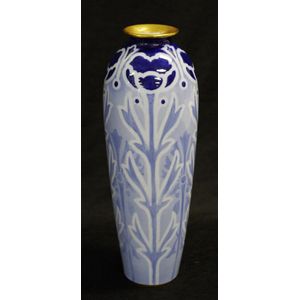Blue and White Doulton Burslem Bone China Vase
You must be a subscriber, and be logged in to view price and dealer details.
Subscribe Now to view actual auction price for this item
When you subscribe, you have the option of setting the currency in which to display prices to $Au, $US, $NZ or Stg.
- Circa - A Latin term meaning 'about', often used in the antique trade to give an approximate date for the piece, usually considered to be five years on either side of the circa year. Thus, circa 1900 means the piece was made about 1900, probably between 1895 and 1905. The expression is sometimes abbreviated to c.1900.
- Bone China - Bone china, Also called 'English china", is one of the three types of porcelain, the other two being soft paste porcelain and hard paste porcelain.
Porcelain is an ancient ceramic material, first made in China, hence the common name "china", and the introduction of bone china was to counter the imports of Chinese porcelain.
The initial development of bone china is credited to Josiah Spode, who introduced it around 1800 and it was soon after copied by other manufacturers including Minton, Coalport, Davenport, Derby, Worcester, Wedgwood and Rockingham and the Herculaneum factory at Liverpool.
Spode's bone china was made by mixing ash from cattle bones with feldspar and kaolin, which created a material that was stronger, more translucent, and whiter than traditional porcelain. He began to produce this new type of porcelain in 1796 and it quickly became very popular.
At the time, the process and ingredients were kept secret and were only known to a few manufacturers and were protected by patents.
In the 19th century, bone china became increasingly popular and was widely produced by many manufacturers in England. During this time, it was considered a luxury item and was often used to create fine dining sets and other decorative items.
Bone china is still used in the production of fine porcelain wares, such as tea sets, figurines, and other decorative pieces. His basic formula of six parts bone ash, four parts china stone, and three and a half parts china clay remains the standard English body. It is still considered a luxury item due to its strength, translucency, and whiteness, and is often used for high-end and high-quality porcelain. China.
This item has been included into following indexes:
-
Royal Doulton (England), item types
- blue and white vases 25
- Burslem 388
- ovoid and baluster shaped vases 1,515
Visually similar items

Moorcroft limited edition 'Spirit of Liberty' vase. By Emma Bossoms, #108/200, 2001. Height 37 cm

A Rene Lalique Herblay vase, designed 1932, the tapering cylindrical body moulded with a continuous pattern of fan motifs, in frosted and opalescent glass with a blue patina, acid etched R. Lalique France, 18 cm high. Provenance: G.D Renshaw, Grays Antique

An impressive blue and white 'Three Friends' jar Wanli mark and period, of baluster form, the sides painted in deep cobalt blue with pine, prunus and bamboo rising from the base with birds in flight among trailing clouds above, all between a band of lappet

A Japanese stoneware vase, 20th century, painted with an abstract floral design, signed Anzan or Yasuyuma, 17 cm high
